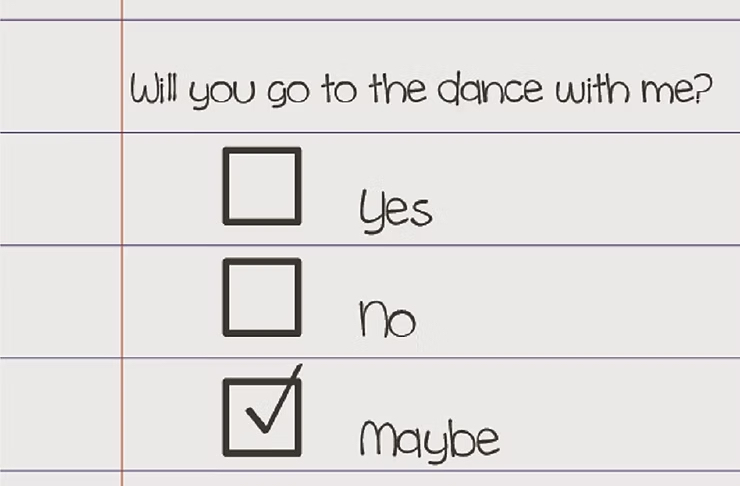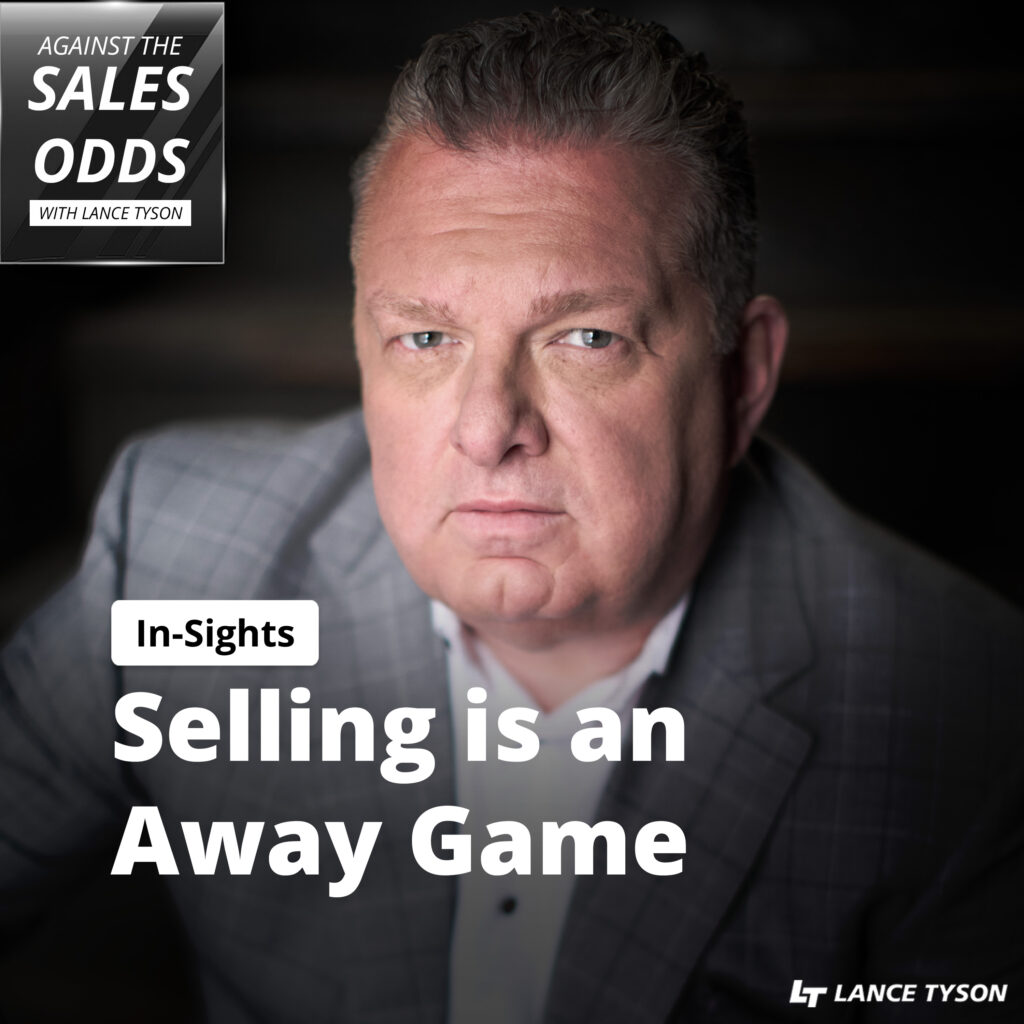- Yes
- Maybe
- No
Now, in this situation, as a 14 year-old boy, you want the Yes. The No is bad for your self-esteem. But the Maybe gives you hope.
I’ll reveal what she said at the end of the post, but for now, let’s talk about how this same situation is a problem for you in your sales activity.
The Challenge of Becoming a Prisoner of Hope
First, an observation: we have too many “maybe” sales responses. Way too many, in fact.
This biggest challenge in B2B selling today is best explained by how every salesperson should conceptualize a pipeline. In general:
- ⅓ of your pipeline will buy from you in the near future
- ⅓ of your pipeline will buy in the far future
- ⅓ of your pipeline will never buy from you — even if you offered them something worth $1 for 90 cents
Sometimes I call sales reps Prisoners of Hope because they don’t ask for the order. In sales, a Prisoner of Hope is someone who continues to accept the maybe response. They spend too much time misinterpreting buying and warning signals, making their sales cycles too long. Or they carry on forever and then just die of attrition in the end.
Click here, download our playbook on resolving objections and get the responses that turn leads into customers.
We’ve all seen these kinds of situations. And some of us have even been in them! They always look and feel like the following with the prospect saying something like:
- “I don’t want to talk right now. But in three months, we can talk…”
- “We need a lot of internal stakeholders to agree before we can commit…”
- “Send me your materials and I’ll take a look…”
- A prospect says, “I’m interested, let’s talk later” and then turns into a ghost. This leaves you resorting to stalking, creeping, doing fly-bys on social media, and calling from unlisted numbers.
Your prospects are being nice. They feel bad about saying no, so they don’t. Instead, they string you along with hope for an uncertain future.
Take Control by Asking for the Order
But here’s the deal: we can’t change them. The only person we can change is ourselves.
Go back to these bullets right above here. See how the first three sales responses end with ellipses? It’s your prospect trailing off. That usually means “no” in reality, but the trail off implies some hope for the sales rep. You become a Prisoner of Hope. You keep your prospects in your pipeline way too long, and they almost never close. 90 percent or more of these Prisoner of Hope situations go nowhere.
All these leads are checking Maybe on your 8th grade note pass. You’ve got hope — but you’ve got no dance card.
No matter how you slice it, this isn’t the best approach in terms of sales tactics. So sales managers, leaders, trainers, and coaches need to start working with sales reps to help them stop accepting maybe as a viable sales response. We need to get them to start asking for the order.
But why? Why am I saying some not-yet-seasoned sales rep should be asking for the order from a potentially big client?
Because of the power of ”No.”
The Power of a “No” Sales Response
Here’s the deal: asking for the order is the beginning phase of getting an objection. You need the objection, the “no”, in order to move to the next step. Conflict drives everything, and that’s especially true in sales.
There’s a famous sales study from the 1970s, done by Mutual of Omaha. The set-up is this: they went to their home market (Omaha) and targeted some folks who would be good customers for them. They picked about 1,000 people and said they’d give them insurance premiums (up to $500,000) for a year, but they had to meet with Mutual’s salespeople in order to get this offer. At the same time, they told 150 sales people that there were 1,000 available leads. The whole transaction was contingent on the salespeople asking a specific closing question. Unless that question was asked, nothing was triggered. There was no close.
So, out of these 1,000 really good, vetted leads — what percentage do you think closed?
It was about 7 percent. About 70 of 1,000 people. And why? Because the salespeople weren’t asking the question. They left about 930 leads on the table because they didn’t ask. That’s amazing!
When your sales reps aren’t asking for the order, they’re not selling strong. Sending a LinkedIn message? That’s not selling strong. Remember, LinkedIn ain’t selling!
So how do you move your sales reps to ask for the order? How do they ask? How do they sell strong?
Three Ideas to Help Your Team Sell Strong
Here are three quick tips:
Be in the moment:
I like scripts and call flows as much as the next guy and I’ve trained people on scripts, working with checklists, and boxes to check. That’s all well and good. But people with purchasing authority in organizations are seasoned. They’ve been around the block and they know the tactics and the angles. They’re going to respond more to a real conversation with ups and downs, small talk and commonalities rather than being sold from a script. Let’s say you go in to see a prospect and you want to sell a season ticket package. You’ve got a whole plan of sales tactics to get there. At minute 3 of this interaction, the guy wants to talk about his vacation to Mo’orea. You’ve never been to Mo’orea and have no idea where it is. So what do you do now? You get in the moment. Listen. Maybe Google a few things about Mo’orea. Talk about how you want to go now too. Sounds awesome! You have to read your prospect and respond in kind. You can go in with a baseline plan, but what happens in the moment matters.
Ask good closing questions:
There are millions of studies about the power of asking good questions. If I tried to link them all here, you’d be reading this post for two weeks. The point is: there are lots of good questions. You need to get to them to make the close. In general, yes/no questions don’t get you as far. If your prospect is busy, yes/no can detach them from the sales process, because they’re just giving you quick, one-word answers. You want to engage your prospect. Make them think. They need to be talking about their pain points and what your solution is going to do for that problem. Remember: some products are sold because they are needed, and some are sold as an opportunity.
Don’t be afraid to ask:
We’ve all been around the guy or gal who can approach a stranger at a bar completely sober and start a conversation. And we know people who need five drinks to make that first move. Confidence varies, and that’s part of the “Prisoner of Hope” problem I described earlier. But you must jump over the confidence hurdle and ask. It’s the only way to receive. What’s the worst that happens? The prospect says no? If they say no, there’s the conflict! You can drive forward from there.
This is my baseline approach to the sales strategy of the power of no, and using conflict to drive forward. We need to get to high ground and shut down the idea of artificial harmony quickly. Use conflict to drive sales forward and get to the close.
By the way, the girl said maybe.
To get a better handle on resolving objections, download the playbook, Seven Steps to Resolving Sales Objections here and make objections work for you!




